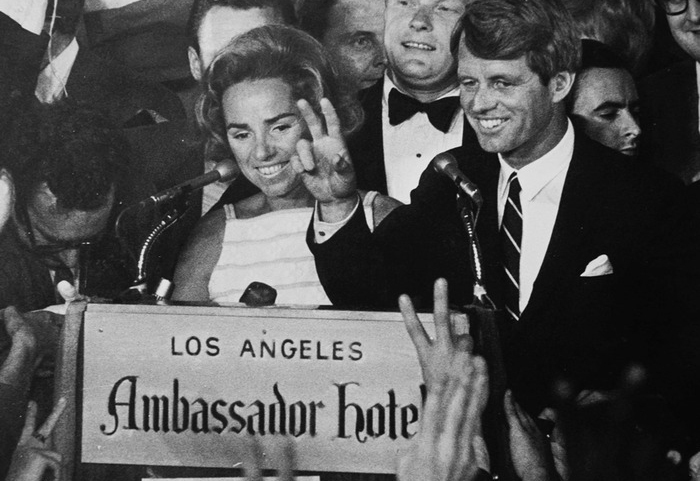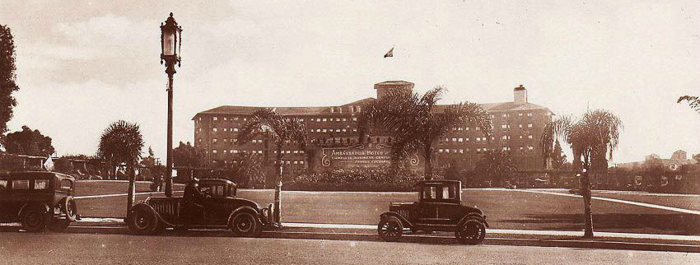For updates join our campaign on Facebook
![]()
Welcome to the Indiegogo campaign for After 68!
We are honored to have the opportunity to be the first filmmakers ever to chronicle the remarkable story of the Ambassador Hotel, Los Angeles. We hope to use this film to raise awareness about the importance of historic preservation worldwide.
![]()
Risks, Challenges & Why Indiegogo?
The greatest obstacle we face as documentarians on this project is the passing of time. All that remains of the Ambassador are the rich oral histories of the many surviving guests and other people involved with the hotel. We launched this campaign to raise the funds we need to finish capturing these invaluable stories before they are lost for good. We cannot do this without your help!
![Click the "Share" button to share the trailer with your friends to revive the memory of the Ambassador and promote the values of Historic Preservation.]()
Click the "Share" button to share the trailer with your friends to revive the memory of the Ambassador
![]()
![]()
After 68 is a feature length documentary film that examines historic preservation through the lens of the 15-year struggle to save the famed Ambassador Hotel from demolition. This film will recount the monumental history of the Ambassador and investigate the importance of historic preservation within contemporary urban landscapes.
The Ambassador Hotel was a celebrated landmark and an iconic symbol for both Los Angeles and the nation. While many associate the Ambassador Hotel with the assassination of Robert Kennedy in 1968, the Ambassador’s role in history was much more pervasive. Considered at one time to be "the most famous hotel in the world”, the Ambassador is unmatched for its impact on local and national history. After 68 will uncover its rich history and demonstrate that it was a touchstone for our nation that played a pivotal role in the development of arts, culture, politics, and architecture.
![]()
![]()
![]()
By exploring the history of the Ambassador Hotel and its demolition we hope to inspire audiences to appreciate the value of historic preservation and the effect it can have in their own communities. The Ambassador’s story marks the irrecoverable loss of an important piece of human and social history. As filmmakers we want to educate the public about the value of protecting our past, and thereby ensure that the other Ambassadors of the world may be saved.
In cities across the globe, aging structures and historic buildings meet their end as wrecking balls tear them down, erasing the rich stories that reside behind their walls. In a constantly evolving urban landscape historic preservation and urban renewal both share an important stake in defining civic identity.
![Buildings lost to the wrecking ball: Penn Station, New York - US Post Office, Boston - Biltmore Hotel, Oklahoma City - Stock Exchange Building, Chicago]() Buildings lost to the wrecking ball: Penn Station, New York - US Post Office, Boston - Biltmore Hotel, Oklahoma City - Stock Exchange Building, Chicago
Buildings lost to the wrecking ball: Penn Station, New York - US Post Office, Boston - Biltmore Hotel, Oklahoma City - Stock Exchange Building, Chicago
In documenting the Ambassador’s history we hope to demonstrate that historic buildings can be real-world history lessons that give us a sense of connection to the past. Historic preservation advances an experiential sense of community by cultivating pride and belonging, thereby furthering a community’s personal stake in their neighborhoods and cities.
![]()
![]()
WHAT YOUR PLEDGE WILL FUND
Your generous support will help us rescurrect the legacy the Ambassador by providing funding for:
Production expenses including travel, personnel/crew, and equipment rental. Furthermore funding from this campaign will help pay for transcription of footage, an updated film trailer to reflect completed footage and inital post-production editing expenses.
SHARE
Millions of memories were made at the Ambassador, if we can raise $1 for just a fraction of them, together we can make this film happen. Please share this project with your family, friends, and colleagues through social media like Facebook and Twitter and give them the opportunity to help us immortalize the Ambassador's legacy.
![]()
![]()
![]()
The Most Famous Hotel In The World:
The Ambassador Hotel, Los Angeles
The Crown Jewel Of Wilshire Boulevard
![]()
When the Ambassador Hotel opened on New Year's Day 1921, it was instrumental in fostering the city’s westward expansion. During its sixty-eight years of service, the Ambassador hosted a myriad of dignitaries and royalty from across the globe as well as almost every major 20th century icon including, Albert Einstein, F. Scott Fitzgerald, Winston Churchill, Amelia Earhart, Salvador Dali, Buzz Aldrin, Charles Lindbergh, Babe Ruth, Frank Sinatra and Charlie Chaplin. Every U.S. president from Herbert Hoover to Richard Nixon showed up at its doors; Nixon having written his famous 1952 “Checkers” speech while at the hotel.
![LEFT: Invitation to Albert Einstein's banquet, TOP RIGHT: 19 year old Marilyn Monroe attending a party at the Ambassador hotel, BOTTOM RIGHT: Salvador Dali hanging out in a bathtub]() LEFT: Invitation to Albert Einstein's banquet, TOP RIGHT: 19 year old Marilyn Monroe attending a party at the Ambassador hotel, BOTTOM RIGHT: Salvador Dali hanging out in a bathtub.
LEFT: Invitation to Albert Einstein's banquet, TOP RIGHT: 19 year old Marilyn Monroe attending a party at the Ambassador hotel, BOTTOM RIGHT: Salvador Dali hanging out in a bathtub.
Tthe hotel’s historical relevance was indisputably recognized in multiple arenas outside of entertainment. The Ambassador was a “city within a city.” For decades it was the center of community and political life in a quickly expanding urban center. Serving the local community and guests with over 33 retail stores and services, the hotel became part of the fabric of daily life for Angelenos.
![]()
Hollywood and the world famous Cocoanut Grove
When it opened in 1921, the Cocoanut Grove instantly became a mecca for movie stars and star-gazers.
![]()
The Ambassador was introduced to the world stage through its famed nightclub, The Cocoanut Grove. Considered the “Playground of the Stars,” the Cocoanut Grove was frequented by Hollywood celebrities, gossip columnists, and entertainment reporters for decades where patrons dined and danced to musical entertainment by popular orchestras and artists.
![]()
Live broadcasts from the Cocoanut Grove were a popular feature of nighttime radio, allowing millions of people to enjoy and even dance to the music in their homes. Performances led by famous bandleaders such as Abe Lyman and Gus Arnheim were broadcast around the globe and famous artists like Judy Garland, Nat King Cole, Bing Crosby and The Supremes performed nightly.
![Singer Harry Belafonte Performing at the Coconut Grove Nightclub]() Singer Harry Belafonte Performing at the Coconut Grove Nightclub
Singer Harry Belafonte Performing at the Coconut Grove Nightclub
The Cocoanut Grove also was home to six Academy Awards ceremonies, including the first ceremony to feature the Oscar statuette in 1930. In 1939 the Grove provided the stage for the historical ceremony in which the first African-American - Hattie McDaniel - won the award for Best Supporting Actress. The Ambassador was said to have launched the careers of Joan Crawford, Merv Griffin, and Barbra Streisand. Marilyn Monroe also signed her first modeling contract with the Blue Book Modeling Company at the hotel.
![]()
![]()
A Fall From Grace: Robert F. Kennedy
![]()
On June 5, 1968 an event that shocked the nation and the world tragically unfolded in the pantry of the Ambassador Hotel kitchen. After winning the California Democratic presidential primary election, Senator Robert F. Kennedy was shot by Palestinian immigrant, Sirhan Sirhan, as he was exiting the hotel's Embassy Ballroom.
After '68
![Sammy Davis Jr.'s The Grove]() Sammy Davis Jr.'s The Grove
Sammy Davis Jr.'s The Grove
After 1968 the hotel’s image was tarnished and its popularity began to wane. By the 70's business at the hotel began to suffer as the surrounding neighborhood experienced a spike in crime and gang activity. In an attempt to bring the languishing nightclub back to life in the 1970's, Sammy Davis Jr. remodeled the Cocoanut Grove into a Las Vegas-style showroom. Owners of the hotel also neglected to repair and maintain the structure as they too were struggling financially. Consequently, after 68 years of service to the world, the hotel finally closed it's doors to the public in 1989.
Filming At The Ambassador Hotel
For decades Hollywood used the hotel as one of the most filmed locations in the entertainment industry. The 24-acre property gave filmmakers a wide range of locations to use as sets. As the hotel was being demolished in 2005, Emilio Estevez’s Bobby was the last film to be shot at the hotel. Check out the montage to see just a few of the films that were shot there.
CHECK OUT THIS VIDEO MONTAGE OF THE CLASSIC FILMS SHOT AT THE AMBASSADOR
From Glory To Dust
![The Ambassador Hotel, Los Angeles circa 1921]() The Ambassador Hotel, Los Angeles circa 1921
The Ambassador Hotel, Los Angeles circa 1921
After the Ambassador closed, Donald Trump purchased the property with plans to demolish the hotel and construct the world's tallest tower. He abandoned this plan nearly a decade later, after finding himself entangled in a web of deals and law suits with the L.A. school district, who was also interested in the property.
Meanwhile, education proponents and preservation advocates wrestled over the future of the property. Both parties agreed that building a school campus on the Ambassador site would be a valuable use of the space. Unfortunately for the hotel, the school district claimed that they didn't have enough money to restore the building, and felt that education was more important to the community than historic preservation. The Conservancy and a coalition of over 70 organizations disagreed, contending it was possible to cost effectively re-purpose the celebrated hotel, and create a unique learning environment for students. One in which curriculum could be infused with the hotel’s rich history, a win-win situation.
![]()
After 15 years of debate the Ambassador's fate was sealed on October 12, 2004 when the school district voted to tear down the hotel. By 2011, the cash‐strapped school district finally finished building the campus. At a cost of $578 million it is the most expensive school ever built in the U.S. to date. Today, the new school is serving the community but the Ambassador remains only as a relic in our collective memories; a haunting symbol of yet another missed opportunity for historic preservation.
![]()
FILM STATUS
Between 2005-2007, we had the opportunity to shoot 14 key interviews with individuals who shared their stories about the Ambassador, as well as get final footage of the hotel while it was being demolished. But we still have several interviews that need to be shot in order to complete the film. With a successful Indiegogo campaign we plan to interview people who can speak about the role of historic preservation and the lessons learned from losing the Ambassador. Funds raised will go towards upgrading our camera equipment in addition to travel expenses and equipment rental costs. We will also be able to hire the crew and production staff necessary to finally finish production on the film and take us into initial post-production.
![Behind the scenes, After 68 Interview - Tempe, Arizona]() Behind the scenes, After 68 Interview - Tempe, Arizona
Behind the scenes, After 68 Interview - Tempe, Arizona
![]()





























































 Buildings lost to the wrecking ball: Penn Station, New York - US Post Office, Boston - Biltmore Hotel, Oklahoma City - Stock Exchange Building, Chicago
Buildings lost to the wrecking ball: Penn Station, New York - US Post Office, Boston - Biltmore Hotel, Oklahoma City - Stock Exchange Building, Chicago



 LEFT: Invitation to Albert Einstein's banquet, TOP RIGHT: 19 year old Marilyn Monroe attending a party at the Ambassador hotel, BOTTOM RIGHT: Salvador Dali hanging out in a bathtub.
LEFT: Invitation to Albert Einstein's banquet, TOP RIGHT: 19 year old Marilyn Monroe attending a party at the Ambassador hotel, BOTTOM RIGHT: Salvador Dali hanging out in a bathtub.

 Singer Harry Belafonte Performing at the Coconut Grove Nightclub
Singer Harry Belafonte Performing at the Coconut Grove Nightclub

 Sammy Davis Jr.'s The Grove
Sammy Davis Jr.'s The Grove The Ambassador Hotel, Los Angeles circa 1921
The Ambassador Hotel, Los Angeles circa 1921
 Behind the scenes, After 68 Interview - Tempe, Arizona
Behind the scenes, After 68 Interview - Tempe, Arizona

















